Description
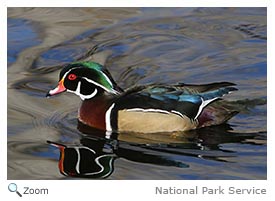 The wood duck is a dabbling duck. It is
19-21
inches in length with a wingspan of
26-29
inches. It has a long tail, a small bill, a blue-green patch bordered with a white line on its wings, and a crest on its head. The male has an
iridescent green, blue, and purple
head with a long crest that runs down the back of his head like a helmet! A white line runs from the side of his head to the back of his crest. He has a white throat and a white chin strap. His bill is a bright red and has a yellow base and a dark tip. He has a brownish-red chest, grayish-yellow sides surrounded with a white line, a black back and tail, and a white belly. The wood duck is a dabbling duck. It is
19-21
inches in length with a wingspan of
26-29
inches. It has a long tail, a small bill, a blue-green patch bordered with a white line on its wings, and a crest on its head. The male has an
iridescent green, blue, and purple
head with a long crest that runs down the back of his head like a helmet! A white line runs from the side of his head to the back of his crest. He has a white throat and a white chin strap. His bill is a bright red and has a yellow base and a dark tip. He has a brownish-red chest, grayish-yellow sides surrounded with a white line, a black back and tail, and a white belly.
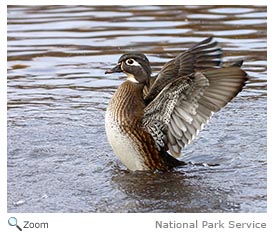 The female has a smoky gray head, a white chin and throat, a grayish-brown chest, brown sides, and a white belly. She has white circles around her eyes, bluish wings, and a black tail. The female has a smoky gray head, a white chin and throat, a grayish-brown chest, brown sides, and a white belly. She has white circles around her eyes, bluish wings, and a black tail.
Range
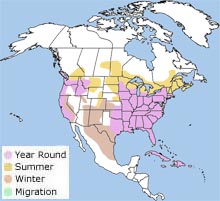 The wood duck breeds
from southern Canada throughout the eastern half of the United States and south to Cuba. In the west, the wood duck breeds from British Columbia southward along Pacific Coast to southern California. It winters
in the southern part of its breeding range and in Mexico. The wood duck breeds
from southern Canada throughout the eastern half of the United States and south to Cuba. In the west, the wood duck breeds from British Columbia southward along Pacific Coast to southern California. It winters
in the southern part of its breeding range and in Mexico.
| |
Habitat
The wood duck is found in wooded wetlands including rivers, streams, creeks, swamps, marshes, ponds, and lakes.
Diet
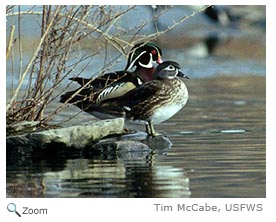 The wood duck eats
seeds, acorns, and other small nuts;
grains; fruits; and algae. It also eats aquatic plants like pondweeds,
cypress seeds, sedges, grasses,
and duckweed. It will also eat aquatic insects and other invertebrates. The wood duck eats
seeds, acorns, and other small nuts;
grains; fruits; and algae. It also eats aquatic plants like pondweeds,
cypress seeds, sedges, grasses,
and duckweed. It will also eat aquatic insects and other invertebrates.
Life Cycle
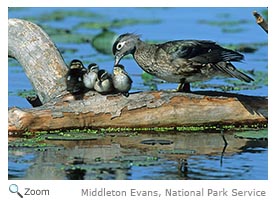 Male and female pairs form in the winter, before the wood ducks reach their breeding grounds.
The female lays 6-15 eggs in a tree cavity near water. The nest can be as high as 50 feet above the ground. The female lines the nest with down from her breast. She incubates the eggs for about 30 days. About two days after hatching, the ducklings jump down from the nest and make their way to water by following their mother's call. The ducklings fledge when they are about 56-70 days old. The female may have two broods a year. The male usually mates with only one female each season. Male and female pairs form in the winter, before the wood ducks reach their breeding grounds.
The female lays 6-15 eggs in a tree cavity near water. The nest can be as high as 50 feet above the ground. The female lines the nest with down from her breast. She incubates the eggs for about 30 days. About two days after hatching, the ducklings jump down from the nest and make their way to water by following their mother's call. The ducklings fledge when they are about 56-70 days old. The female may have two broods a year. The male usually mates with only one female each season.
Behavior
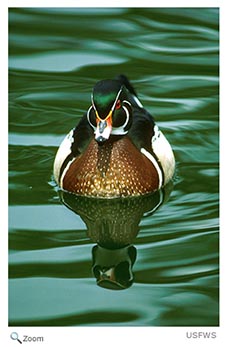 The wood duck was close to extinction in the 1900s due to overhunting. The Migratory Bird Treaty established in 1916 and the enactment of the Federal Migratory Bird Treaty Act in 1918 helped increase wood duck populations by the 1920s. In the 1930s, nest boxes came into use and the wood duck population continued to grow. The wood duck was close to extinction in the 1900s due to overhunting. The Migratory Bird Treaty established in 1916 and the enactment of the Federal Migratory Bird Treaty Act in 1918 helped increase wood duck populations by the 1920s. In the 1930s, nest boxes came into use and the wood duck population continued to grow.
|

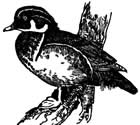


 The wood duck breeds
from southern Canada throughout the eastern half of the United States and south to Cuba. In the west, the wood duck breeds from British Columbia southward along Pacific Coast to southern California. It winters
in the southern part of its breeding range and in Mexico.
The wood duck breeds
from southern Canada throughout the eastern half of the United States and south to Cuba. In the west, the wood duck breeds from British Columbia southward along Pacific Coast to southern California. It winters
in the southern part of its breeding range and in Mexico.


